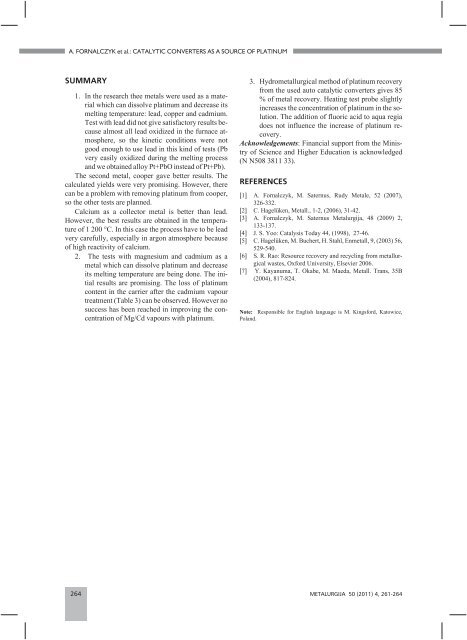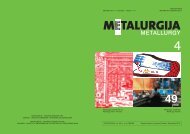PDF - 2453 kB - CARNet
PDF - 2453 kB - CARNet
PDF - 2453 kB - CARNet
Create successful ePaper yourself
Turn your PDF publications into a flip-book with our unique Google optimized e-Paper software.
A. FORNALCZYK et al.: CATALYTIC CONVERTERS AS A SOURCE OF PLATINUM<br />
SUMMARY<br />
1. In the research thee metals were used as a material<br />
which can dissolve platinum and decrease its<br />
melting temperature: lead, copper and cadmium.<br />
Test with lead did not give satisfactory results because<br />
almost all lead oxidized in the furnace atmosphere,<br />
so the kinetic conditions were not<br />
good enough to use lead in this kind of tests (Pb<br />
very easily oxidized during the melting process<br />
and we obtained alloy Pt+PbO instead of Pt+Pb).<br />
The second metal, cooper gave better results. The<br />
calculated yields were very promising. However, there<br />
can be a problem with removing platinum from cooper,<br />
so the other tests are planned.<br />
Calcium as a collector metal is better than lead.<br />
However, the best results are obtained in the temperature<br />
of 1 200 °C. In this case the process have to be lead<br />
very carefully, especially in argon atmosphere because<br />
of high reactivity of calcium.<br />
2. The tests with magnesium and cadmium as a<br />
metal which can dissolve platinum and decrease<br />
its melting temperature are being done. The initial<br />
results are promising. The loss of platinum<br />
content in the carrier after the cadmium vapour<br />
treatment (Table 3) can be observed. However no<br />
success has been reached in improving the concentration<br />
of Mg/Cd vapours with platinum.<br />
3. Hydrometallurgical method of platinum recovery<br />
from the used auto catalytic converters gives 85<br />
% of metal recovery. Heating test probe slightly<br />
increases the concentration of platinum in the solution.<br />
The addition of fluoric acid to aqua regia<br />
does not influence the increase of platinum recovery.<br />
Acknowledgements: Financial support from the Ministry<br />
of Science and Higher Education is acknowledged<br />
(N N508 3811 33).<br />
REFERENCES<br />
�1� A. Fornalczyk, M. Saternus, Rudy Metale, 52 (2007),<br />
326-332.<br />
�2� C. Hagelüken, Metall., 1-2, (2006), 31-42.<br />
�3� A. Fornalczyk, M. Saternus Metalurgija, 48 (2009) 2,<br />
133-137.<br />
�4� J. S. Yoo: Catalysis Today 44, (1998), 27-46.<br />
�5� C. Hagelüken, M. Buchert, H. Stahl, Enmetall, 9, (2003) 56,<br />
529-540.<br />
�6� S. R. Rao: Resource recovery and recycling from metallurgical<br />
wastes, Oxford University, Elsevier 2006.<br />
�7� Y. Kayanuma, T. Okabe, M. Maeda, Metall. Trans, 35B<br />
(2004), 817-824.<br />
Note: Responsible for English language is M. Kingsford, Katowice,<br />
Poland.<br />
264 METALURGIJA 50 (2011) 4, 261-264

















